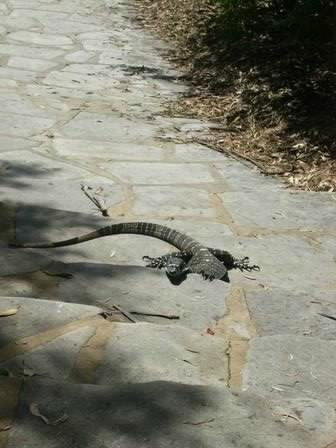
 |
The varanids, better known as monitor lizards, constitute one of the smallest but most important families of lizards. Whereas the success of geckos and skinks is doubtlessly due to their small size and adaptability, monitors must attribute their own success to their toughness, pugnacious and often large size. Some monitor species rank very highly in their local food chain, reaching the very top on the island of Komodo, Indonesia.
Not all monitors are giants: there are some dwarf species in Australia that only reach about 12" or so. However, monitors can be characterised by the following: long, powerful tail used for defence: five digits on each foot, each with a fairly strong claw: a long neck: and a forked tongue very reminiscent of that of a snake. The eyes are round and lidded. All monitors are egg-layers. The psychology of most varanids varies from watchful to downright aggressive: certainly they are more fearless than many other lizards. Socially most monitors are also loners: there is no pair bonding or colonial structure, although rarely some individuals will return to the same mate each year.
Monitor lizards as pets are a proposition that requires a lot of consideration on the part of the would-be owner. It has often been noted that the ones most commonly available (Savannahs, Niles and Water Monitors) often vary from indifferent to bad choices as pets. There are smaller species, but these are usually Australian in origin and hence either unavailable or extremely expensive. To keep the larger species, even medium-sized ones like Savannahs, requires a large cage and preferably some room for the monitor to exercise in, since they all too often grow fat and lazy in captivity. Some may also require a body of water for bathing. The temperament of the proposed species to be kept should also be checked out: Nile Monitors in particular are hard to tame down and often end up as bad-tempered and off-putting creatures who are a strain rather than a joy to keep.
A Brief Guide to the Varanids (Monitor Lizards).
Daniel Bennett has done lot of work with monitors and his page is well worth visiting.
Index of Monitor-related articles from herpetological magazines